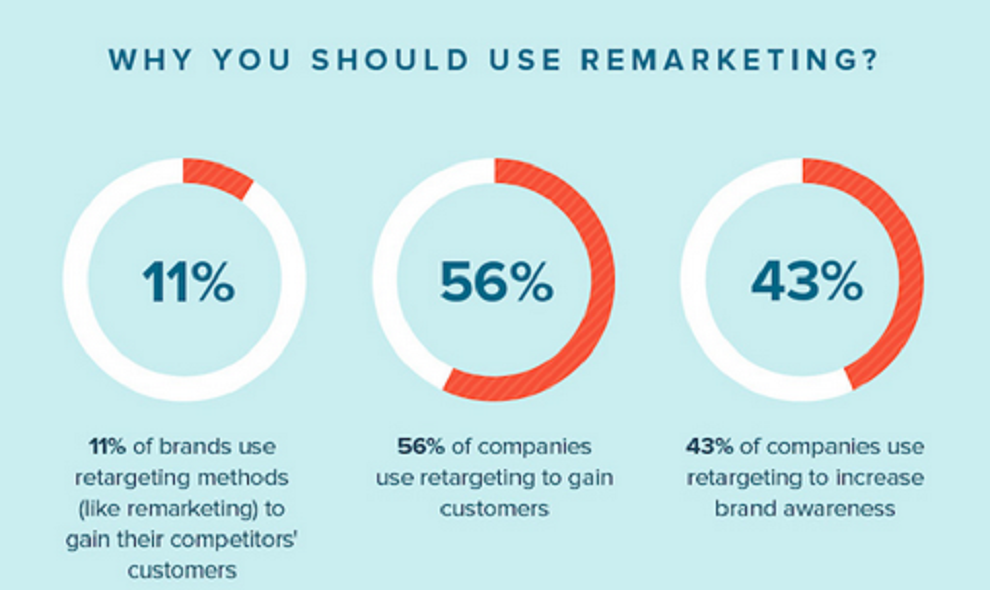Perhaps you spotted a nice bag on an online shopping store that intrigued you, and you felt like checking it out. So, you went through its features, and its cost because you found it interesting, and then you went about your business for the day.
Suddenly, the next day, or perhaps a few days later, you come across an ad featuring that very bag while scrolling through an interesting blog. (Retargeting). “Huh! That’s weird!” you think, “I checked that same bag out a few days back!”. You take notice, but you brush it off as a coincidence, and go about with your life again…
However, later that night, while scrolling through Facebook, there it is again! Another ad with the same bag! And you are really intrigued by this repeated occurrence. But this will happen a few more times over the period of the next few days, and you’ll go, “What’s going on?! Is this bag stalking me?”
The cursed bag of an ancient Egyptian priest perhaps? Nope. You’re just being retargeted. Let us try to understand what that means…

In a world that has all sorts of different people, all sorts of cultures, millions of restaurants, and food joints that serve burgers, and fries, and so you could’ve thought of anything, yet you had that one brand-name dominating your thoughts when you saw that image.
The reason is really simple: it happens to be the one with the highest number of outlets in the world, and you are more likely to have come across one of its joints, more than any other food joint. And so, every time you hear cheeseburger, the brand pops up in your mind!
An ancient marketing folklore states that during the customer journey, if they come across your brand seven times, they are more likely to make the purchase.
So, digital businesses across the globe have been using this to their advantage. No, they are not all opening up shops in every other street, because that would mean a lot of expenses,… and the digital world is quite conscious about budgets. What they are actually doing is something called “Retargeting”.

So what is this “Retargeting”?

Once a potential customer opens a webpage to view the item that they’re interested in, a cookie (a small piece of data) is set on their browser. These cookies allow the business to access potential customers who visited their web-store but exited without converting (making the purchase).
Similarly, a cookie is set when a prospect adds an item to their cart but leaves without making the purchase. These cookies will help marketers show these prospects the relevant ads about those products that they viewed, and as per the strategies that suit their position in their individual customer journey. This is known as Retargeting.
And if you are worried about privacy, then let us reassure you that retargeting does not involve sharing a users or a visitors personal information with anyone. And, in fact, when the cookies are cleared (when the cache memory is cleared), the user will not be displayed any retargeting ads from the pages that they visited in the past.
Although they will continue receiving retargeting emails from the businesses on whose websites they signed up, to receive updates over email (until they unsubscribe manually).
Retargeting is also carried out using pixels. Pixels are similar to cookies, but tracking pixels send information directly to the servers, and so, this mechanism does not rely on the user’s browser.
This is the reason why pixels are able to follow users across all their devices. Pixels do not invade privacy either, but as they are not present as cache data over the browser, users cannot disable pixels like they can disable cookies.
Retargeting vs. Remarketing
When it comes to reaching/reminding your prospects about your products, and services, there are two words we come across every now, and then: Remarketing, and Retargeting.

There is still a lot of confusion between these terms (that took shape when Google launched their Retargeting system which it referred to as “Remarketing Tool”, back in 2010), and sometimes even use them interchangeably. But actually, they are quite distinct.
Remarketing is when you tell previous customers, people who have already purchased something from you, about other products/services you have to offer that they might be interested in. Remarketing is primarily carried out over email.
Whereas, Retargeting is when ads target prospects who had earlier landed on your website, and were interested in your product(s), but left the site without making the purchase (bounce). Retargeting is mostly carried out using display ads.
So why are these techniques disproportionately successful in getting you conversions?
Most people take time to come to the decision to make the purchase, and there are a multitude of reasons for that…they might have been interrupted by someone or something, they might just be reviewing their options, they might not be sure if they need that product…there could be a lot of reasons.
In fact, the primary bounce rates are so high that only about 2-3% of the first-time viewers make the purchase in one go!
However, if a person at least made the effort to view your product/service, they are definitely interested in what you’re offering at the least. The audience recognizes you from before, and with their demonstrated interest, you can safely assume that you have set a good rapport with them!
And, since they are already interested, they are more likely to buy! And, that is exactly the thought behind Retargeting: “re-target” your ads towards the crowd that already showed interest.
Types of Retargeting

Search Retargeting
Search retargeting is when a person is targeted on the basis of (the assumptions made as per) their previous searches. This type of retargeting is usually carried out using Display Ads.
Site Retargeting
This is used to retarget people who have previously visited your website. A pixel needs to be added over your webpage that sets a cookie in the visitor’s browser which will allow you to display Ads to the person elsewhere.
Email Retargeting
When a person, who has shared his or her email address while signing-up to receive updates/newsletters over email, views a product on the site, but does not make the purchase, you can retarget them through email.
Link Retargeting
This can be carried out to target even those people who have never actually visited your website. You do this by putting your pixel code in a link that you control. This link could be a part of the content that you share over any platform. In this way, you pixel whoever clicks on the link!
Social Retargeting
This is when you serve the prospect, who had visited your site earlier, with Ads on Social Media.
So, how much should you spend on retargeting? We cannot tell you that because every business has different needs, different constraints (budgets), but majority of businesses spend between 25-30% of their total marketing budgets on retargeting! And it sure works like a charm!
Numbers?
Good retargeting campaigns have demonstrated a whopping 10x increase in CTRs (Click Through Rates)! Interestingly, visitors retargeted with display ads are 70% more likely to convert on the website. And through retargeting, the Ad-Engagement rates are up by 400%!
Advantages of Retargeting

Better Conversion Rates
The people who have contemplated buying, or at least somehow shown interest in your business previously, are more likely to actually buy, than the lot that is completely oblivious to your existence. So, you get better conversion rates!
Reduced Ad Costs
Again, when you target the same lot of prospects who have previously shown interest, you are in an audience set that is more open to your product(s)/service(s), and hence with less efforts (costs), you are likely to reap more benefits
Improved Returns on Investment
Smaller, and Filtered Target Audience + Better Conversion Rates + Reduced Ad Costs = Improved ROI
Cost Effective Branding
Not once did we name the fast-food brand, that we started off understanding this topic with, and yet you knew what we were referring to. And, even if you belong to the miniscule population that did not immediately think of that brand, when you saw that picture, you still know which brand we assumed you thought of.
That is how powerful, repeated encounters with a brand can be! So, retargeting also helps you carry out branding. That’s killing two birds with a single stone for you!
The Drawbacks of Retargeting
Retargeting really is a beneficial practice for the growth of your business. However, there are certain disadvantages of Retargeting too. Public fears regarding invasion of privacy (although quite unfounded), the feeling of being stalked, pestered.
Okay, “disadvantage” is a strong word, so let’s say Retargeting, much like everything else that humans indulge in, can be bad if done improperly or excessively. Neil Patel’s take on the Dark Side of Retargeting is quite enlightening.
Did you like reading about Retargeting? Many such strategies can be used for your business growth. If you are looking for professional help with your marketing, check out our services.













